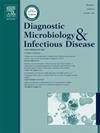Radiotracers for in situ infection imaging: Experimental considerations for in vitro microbial uptake of gallium-68-labeled siderophores
IF 2.1
4区 医学
Q3 INFECTIOUS DISEASES
Diagnostic microbiology and infectious disease
Pub Date : 2024-09-07
DOI:10.1016/j.diagmicrobio.2024.116522
引用次数: 0
Abstract
In vitro screening of gallium-68(68Ga)-siderophores in pathogens relevant to infections is valuable for determining species specificity, their effect on cell viability, and potential clinical applications. As the recognition and internalization of siderophores relies on the presence of receptor- and/or siderophore-binding proteins, the level of uptake can vary between species. Here, we report in vitro uptake validation in Escherichia coli with its native siderophore, enterobactin (ENT) ([68Ga]Ga-ENT), considering different experimental factors. Compared with other reporting methods of uptake, ‘% Added dose/109 CFU/mL (% AD/109 CFU/mL),’ considering the total viable count, showed a better comparison among microbial species. Later, in vitro screening with [68Ga]Ga-desferrioxamine B (DFO-B) showed high uptake by Staphylococcus aureus and S. epidermidis; moderate uptake by Pseudomonas aeruginosa; poor uptake by E. coli, Candida albicans, and Aspergillus fumigatus; and no uptake by Enterococcus faecalis and C. glabrata. Except for S. epidermidis, [68Ga]Ga-DFO-B did not reduce the cell viability.
用于原位感染成像的放射性核素:体外微生物吸收镓-68 标记的嗜苷酸的实验考虑因素
体外筛选与感染有关的病原体中的镓-68(68Ga)嗜苷酸盐对于确定物种特异性、其对细胞活力的影响以及潜在的临床应用都很有价值。由于嗜硒酸盐的识别和内化依赖于受体和/或嗜硒酸盐结合蛋白的存在,因此不同物种的吸收水平会有所不同。在此,我们报告了大肠杆菌对其原生嗜苷酸盐肠杆菌素(ENT)([68Ga]Ga-ENT)的体外摄取验证,并考虑了不同的实验因素。与其他报告吸收率的方法相比,考虑到总存活计数的 "添加剂量/109 CFU/mL百分比(AD/109 CFU/mL百分比)"在微生物物种之间显示出更好的可比性。随后,用[68Ga]Ga-去铁胺 B(DFO-B)进行的体外筛选显示,金黄色葡萄球菌和表皮葡萄球菌的摄取率高;铜绿假单胞菌的摄取率中等;大肠杆菌、白色念珠菌和烟曲霉的摄取率低;粪肠球菌和光曲霉没有摄取率。除表皮葡萄球菌外,[68Ga]Ga-DFO-B 不会降低细胞活力。
本文章由计算机程序翻译,如有差异,请以英文原文为准。
求助全文
约1分钟内获得全文
求助全文
来源期刊
CiteScore
5.30
自引率
3.40%
发文量
149
审稿时长
56 days
期刊介绍:
Diagnostic Microbiology and Infectious Disease keeps you informed of the latest developments in clinical microbiology and the diagnosis and treatment of infectious diseases. Packed with rigorously peer-reviewed articles and studies in bacteriology, immunology, immunoserology, infectious diseases, mycology, parasitology, and virology, the journal examines new procedures, unusual cases, controversial issues, and important new literature. Diagnostic Microbiology and Infectious Disease distinguished independent editorial board, consisting of experts from many medical specialties, ensures you extensive and authoritative coverage.

 求助内容:
求助内容: 应助结果提醒方式:
应助结果提醒方式:


